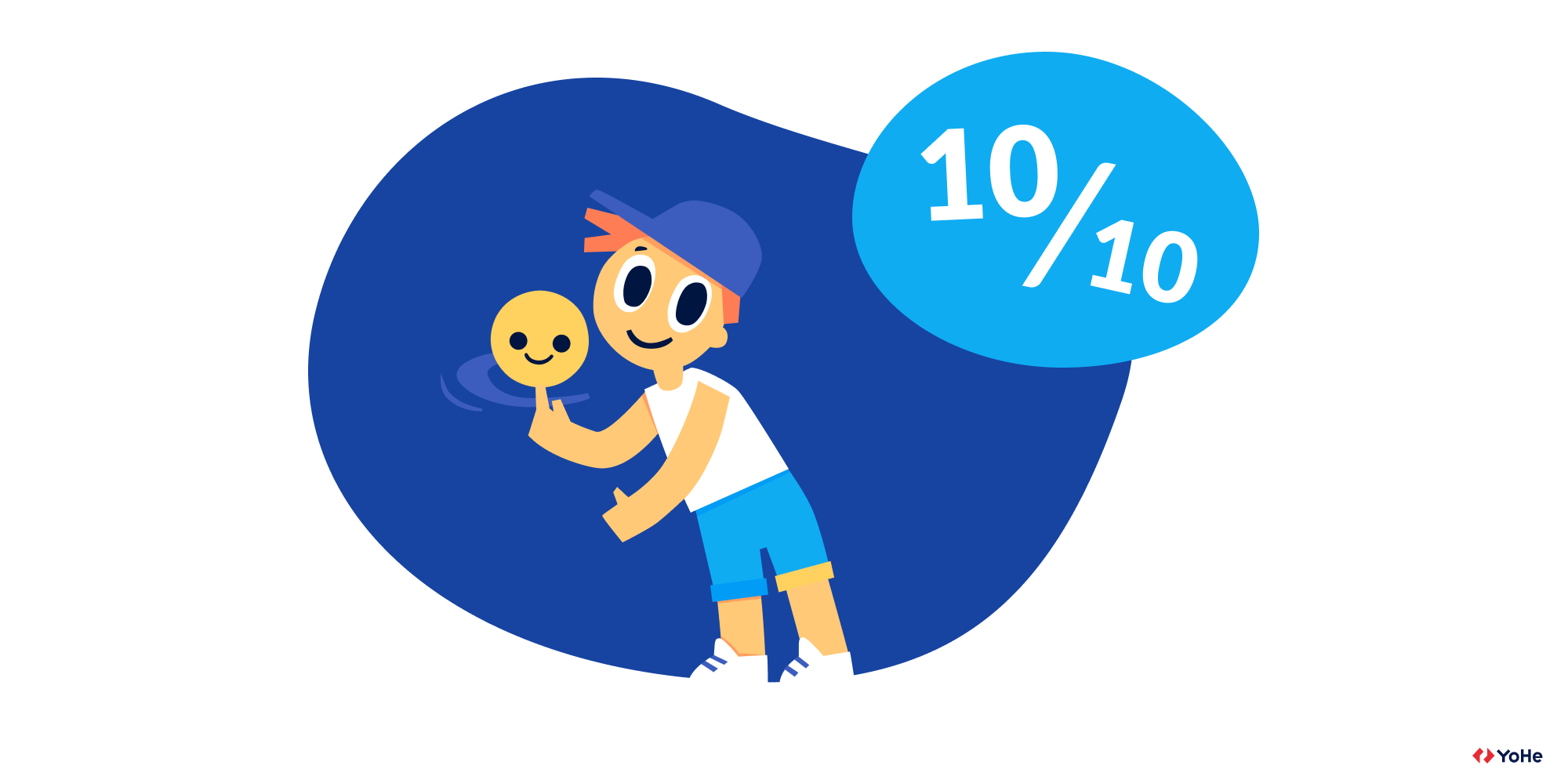CSAT surveys are used to measure the level of customer satisfaction. Sometimes — by some specific processes, be it the convenience of the page after updating, sometimes — more general, like interaction with the site as a whole. Most often, a CSAT survey looks like a rating or emoji scale.
It may look easy to create this type of survey. You choose the question you are interested in and determine how many marks you need on the scale — five, ten, fewer or more. But you will need good preparation and then a profound analysis.
In this material, we will discuss how to get not only a set of numbers from a CSAT survey but also a qualitative result.
Why is it crucial to receive and analyze feedback?
Writer and businessman Harvey McKay once said: "You learn when you listen. You earn when you listen — not only money but also respect." These words are very suitable when working with the customer experience.
The habit of listening to the client is one of the most powerful tools of any company. When you learn about their expectations, you get the key to development. And then increase profits.
In this article, we will tell you how to prepare for the survey. And how to work with the results.

CSAT survey: stages
1. Preliminary preparation
It all starts long before you launch your CSAT survey. When developing it, you need to make sure that each of the questions will subsequently allow you to do something to improve the customer experience. Analyze the survey using this test:
- What will we do if we get a low or high rating?
- For whom in the company is this survey important?
- Who else needs this information?
- Who will do something after receiving the results?
- How quickly can we make changes?
- Can we change that?
- Why are we asking this?
Asking for feedback about what you can't change is pointless. You will only waste your customers' time. As well as your company's time and money. If you can't answer the questions above briefly, the survey needs to be changed. Apply this test every time you develop a survey.
After you have thought about these aspects and answered them, it's time to develop the questions themselves.
Development of questions
Our goal is to catch insights from users, correct mistakes, and make their lives better. None of this will happen if you collect low-quality feedback.
What makes high-quality feedback? Questions! They should be:
- Unambiguous
- Specific (explain or help to understand the reason)
- Relevant (for the person/department that needs to use the results)
- Contextualized (to give an idea of the problem, not just quantitative data)
- Related to what is important to the client
- Related to business results
Based on these parameters, we can offer several recommendations for composing questions for your CSAT.
Don't ask ambiguous or tough questions
For example: "How satisfied are you with the speed and quality of the solution we have offered you?"
In one question — two at once: about the speed and quality of the solution, two very different things. Firstly, it will confuse the respondent. What if the speed was great, but the quality wasn't? Or vice versa? Then it will confuse everyone who needs to process the feedback, because it is unclear what needs to be fixed, one or the other, or both. Link your questions to only one topic.
Don't ask suggestive or biased questions
"We know that you liked our new chocolate bar. How much did you like it?" An example is straightforward, but you understand the essence. Do not distort the question wording by giving it a positive or negative connotation. Just ask what is important for you to know: do not direct the user in a specific direction.
Don't ask only general, superficial questions
For example, a request to "evaluate satisfaction with our site" without additional clarifications or an open-ended question is useless. You will get just numbers, and it will not become clearer what to do with them.
Be specific about open-ended questions
Specify what you want to know. For example: "What can we do to get you to give us 10 the next time you contact us?" Or: "Name one of the most important reasons you would recommend us to your friends."
Provide all possible answers
Make sure you have provided a complete list of answer options. If the user does not find what suits him in the list, he will refuse to continue the survey or choose an incorrect answer. To avoid this, add the open-ended option "Other."
Ask only those questions that are relevant to this client and his experience
Do not allow colleagues to mix too much into your survey in an attempt to get everything at once. If you want to find out whether it is convenient for the user to add products to the cart, you do not need to ask at the same time how he likes that beautiful banner on the main page. Proceed gradually, focusing on one topic in one survey.
Study data from current surveys to create new ones
To get ideas for future surveys, review the answers to the open-ended questions. They are a great source of information and can tell you about a problem that you didn't even know about.
Quality Assurance
In addition to all of the above, do not forget to take the time to QA. Trust someone from your colleagues to double-check your survey. Ask them to evaluate the correctness of the questions, the clarity of the wording, and the technical ability to correct the detected errors.

2. Preparing for launch
Before launching a survey, make sure that after receiving information from the client, it is possible to take action and change something. Not only globally but also quickly. In large companies, a bug ticket may be stuck open for weeks or even months. It is crucial not just to rush to collect feedback but also to be prepared for it.
Being ready for a response
To get started, set up notifications: when you get a mark above or below a set value, responsible employees will receive messages and contact customers.
Next is the stage of responding to the review. To prepare, ask yourself the following questions:
- Who will answer the client?
- How fast?
- How exactly (phone, email, in-person)?
- What will the employees who contacted the client say/ask? (for example, they will apologize, request additional information, schedule a repeat call for more detailed information, etc.)
- How will you ensure your employees can handle these calls?
- What information do they need to call?
- What do you want to get from this call?
- When and how will the error correction take place?
- How will you process the information in the future? Will you share your experience with others to learn something?
- How do you know if the client is satisfied with your work on bugs?
- How do you know if you have saved a client?
By the way, you can also configure success notifications. When customers leave positive feedback or mention specific employees and a job well done, this feedback is sent to the appropriate teams or people. It's not just about bad customer experience and mistakes; it's important to share achievements and consolidate positive actions.
Add customer data to the survey results
Customer information taken from your CRM or call center platform allows you to better understand the response context. What did the user do on the site before he started the survey? Does he often visit your site, or is he visiting for the first time? These and many other questions will help to recreate the whole picture. In addition, if necessary, you should be able to contact the client personally and ask more additional questions.
3. Feedback analysis
You have developed a survey, launched it, and feedback is actively coming in. Hurray! Now you have a lot of data. What now?
Write an analysis plan
Before starting the analysis, you need to develop a plan for it. It is important because it will clarify how you look at the received data, why you need it, and how you will use it.
Here's what the plan should include:
- Goals and objectives of the analysis
- What questions are you trying to answer/problems are you trying to solve
- Who is responsible for each analyzed question
- Data sources (information from surveys, customer data from CRM)
- Who will analyze the feedback and implement insights into the work
Analyze the data
Next, you will analyze the data. One of the best methods is the "Five Whys." Ask the question "Why did this happen?" until you get to the root cause of what happened. For example, a customer added goods into the cart, but closed the site and never returned:
1. The user wrote: "You are deceiving customers! I'm going to the competitors." Why?
2. He spent a lot of time on the site, chose items, and never made a purchase. Why?
3. He added and removed the same products several times. Why?
4. There is no direct relationship between the products that the user added to the cart. Why?
5. After being added to the cart, the prices for the products selected by the user changed. Why?
The problem was found. We did not update the prices of goods in the catalog after the end of the promotion. The user, noticing an increase in the price in the basket, is expected to get angry and go to competitors, and the company loses money. And how many others have not left similar feedback?
In addition to finding out the reasons, it is worth comparing the current data with the past to translate this information into benefits. Suppose the conversion from the cart has become better or worse by 10%. How much exactly did you earn or lose on this?
Contextualize the results
Answering open-ended questions, the user is likely to tell not only about the bugs but also about his wants. These are their wishes, behind which there are real needs. For example, "make the order button green!" is a want. There is a need behind it: the order button is difficult to find, and you can lose part of the profit on this. To see the essence of the problem is to contextualize the data.
Synthesize the results
Then put all the parts of the analysis together to tell the story of what happened to the client. Put this story in a clear context for those who should act on it. The cause-and-effect relationships in this story should be transparent. Only in this case the feedback received can be successfully converted into an improvement in the customer experience.
Socialize the results
Suppose the story is ready to be told. Now we need to socialize the data. Insights should be distributed in the company in such a way your colleagues know what to do with them. Information and recommendations should fall into the hands of teams or departments interested in specific feedback.
It is also important that the insights are in the hands of your managers. Some of the improvements probably relate to the scale of the entire company. They require the participation of senior management to get the right amount of time, funds, and other resources to work.
4. Plan of further actions
Now that the insights are in the hands of people who need to use them to improve the customer experience, it's time to develop an action plan.
Ask yourself:
- What common problems, themes, or trends arise from the data?
- How can/will the department respond to these ideas?
- What will they fix?
- What improvements do they need to make to their processes?
- What additional training is required for their employees?
- What tools do they need?
- What is required to ensure that the entire team or department is aware of the necessary changes?
- Is there any information that they can share with other departments?

5. Reaction to the review
It's time to make changes. Create a prototype to fix a bug or improve the site and test it with customers. Most likely, you will fail the first time. If customers keep saying that interaction is problematic, you will have to start over or fix the prototype you developed. The main thing here is to continue working. CX/UX/UI will not become perfect right away. Prototypes exist to make mistakes, learn and improve the result.
After you implement a new or improved interface, you need to do a couple more things.
Make sure that employees are trained in new tools or processes. After making changes, it should be convenient for everyone — both customers and your colleagues.
Tell your customers exactly what you have done and how their experience will change in the future. It is important to set appropriate expectations so that there are no surprises.
Conclusion
As you can see, if you decide to get feedback from customers, you have a lot of work to do. There are no unimportant elements in this process — preparation, implementation, and analysis require a responsible approach, which means an impressive waste of time and effort. But when everything works out, you will see: all this was not in vain.
Uncompromising win-win is the result that can and should be expected from consistent and high—quality work with feedback.






